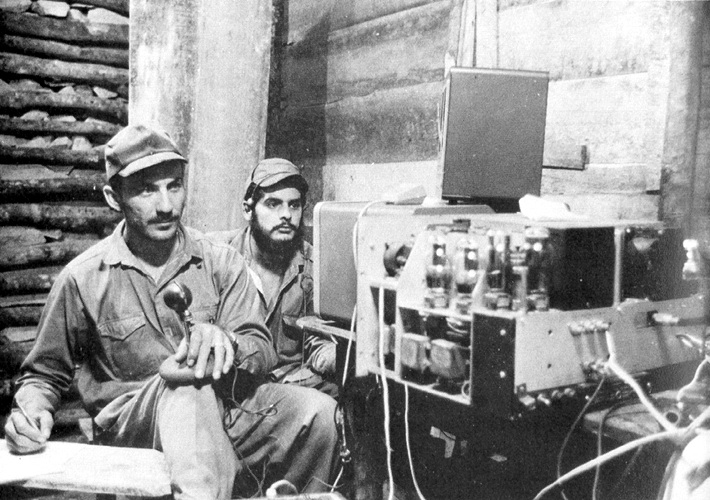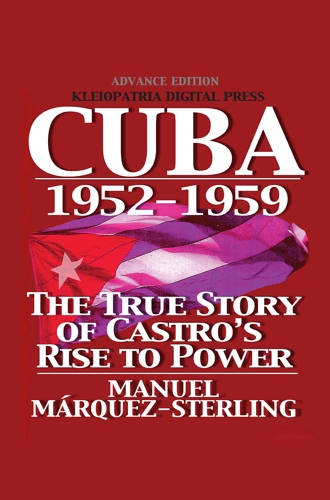February 24, 1958
Exploiting constitutional guarantees of the restored Bill of Rights, M-26-7 rebels begin pirate radio broadcasts from mobile transmitters in the Sierra and supporters’ homes. In the time search warrants can be obtained, the rebels could move transmitters and evade capture.
Angel Pérez Vidal announced the start of Radio Rebelde broadcasts in an M-26-7 press conference primarily focussed on lobbying for a US Cuban embargo on Batista, and publicizing claims that Castro’s campaign to destroy the sugar crop was a great success that had already destroyed two million tons of sugar (almost a third of annual production). These claims were disputed by industry sources, who said rebel claims of damages were about ten times larger than actual damages.
The first Radio Rebelde broadcast (20 minutes) aired on February 24, 1958 from Alto de Conrado in the Sierra, powered by a portable electric generator. It featured Ernesto ‘Che’ Guevara. Subsequent broadcasts began with what would become its signature station identification: “Radio Rebelde here, the voice of the Sierra Maestra, transmitting throughout all Cuba on the 20 meter band at 5 and 9 pm daily…” It also broadcast at 8 and 10 pm on the 40 meter band.
Luis Orlando Rodríguez initially served as Radio Rebelde director of broadcasting, but in a few months those duties were taken over by newspaperman Carlos Franqui, along with other propaganda and public relations responsibilities. Programming included news, revolutionary speeches, anti-Batista rants, musical interludes, and messages from rebels in the mountains to their families. Radio Rebelde also served as a military communication channel, mostly using coded messages, but occasionally transmitting in the clear to engage audiences in the excitement of the revolution through a vicarious sense of participation.
The technical director and founder of Radio Rebelde was Cuban ham (amateur) radio operator Eduardo Fernández. In addition to obtaining and maintaining the equipment, he also selected an initial Alto de Conrado site suitable for broadcasting on the 20 meter band. Fernández would later aid the revolutionary government to bring Cuban amateur radio under state control, precluding future rebel radio stations. Luis Orlando Rodríguez also came out of the Communist closet after 1959, and was appointed to the Council of Ministers.
The Radio Rebelde network eventually grew to 32 satellite stations dispersed throughout Cuba. Satellite stations produced feeds for the main station where daily broadcasts were assembled and transmitted from hub station and relayed satellite relays. The development, growth and sophistication of the network was aided by the US Consul in Santiago de Cuba, Park F. Wollam, one of Castro’s staunchest advocates in the US State Department. Through the efforts of Wollam and others at the consulate, parts and equipment for Radio Rebelde were secretly brought into Cuba and delivered to the rebels in the Sierra.
The viability and success of Radio Rebelde was made possible by the advanced and widespread use of telecommunications in Cuba in 1958. This provided an ample supply of radio equipment and operators, and a population where everyone had a radio. Contrary to Castro’s claims of pre-revolutionary backwardness, 1950s Cuba was far ahead of the region in technology adoption, including telecommunications.
Radio broadcasts on the island started in 1922 and expanded rapidly. By 1957 Cuba had 169 radios per 1,000 people–more than Japan and more than all Latin American countries except Uruguay. In 1957 Cuba had 160 radio stations–more than any other country in Latin America– ranking eighth in the world in number of radio stations, far ahead of all Latin American countries and more than double the number in Austria, France and the United Kingdom.
Barry Mishkind’s Broadcast Archive has a brief article on the History of Cuban Broadcasting by Manuel Alvarez.
 |  |
| Raúl Castro broadcasting on Radio Rebelde, 1958. (photo: Latin American Studies collection) | A Radio Rebelde station in 1958, Oriente Province, Cuba (photo: Latin American Studies collection) |
based on Manuel Márquez-Sterling's Cuba 1952-1959 and
Cuba 1952-1959 Interactive Timeline
Cuba 1952-1959 Interactive Timeline


 Mobile subscription
Mobile subscription



No comments:
Post a Comment